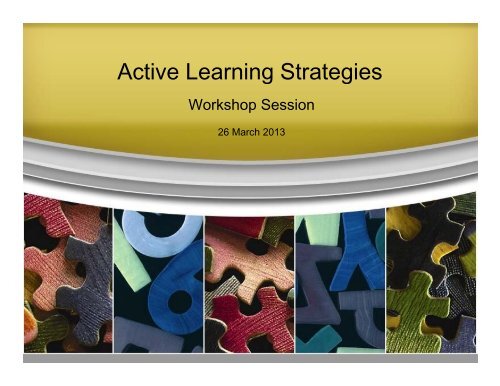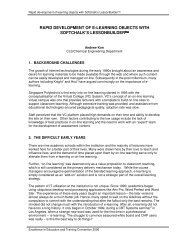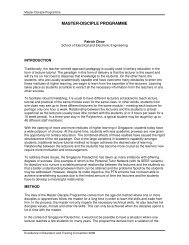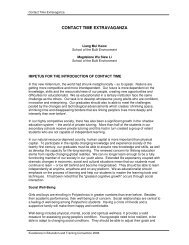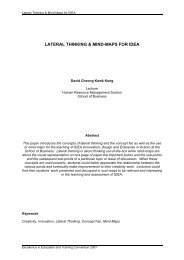Active Learning Workshop - Singapore Polytechnic
Active Learning Workshop - Singapore Polytechnic
Active Learning Workshop - Singapore Polytechnic
Create successful ePaper yourself
Turn your PDF publications into a flip-book with our unique Google optimized e-Paper software.
<strong>Active</strong> <strong>Learning</strong> Strategies<br />
<strong>Workshop</strong> Session<br />
26 March 2013
Education<br />
(images extracted from the Internet)
Outline<br />
• Introduce to sometechniques of active learning<br />
• Experience the way of putting one of the<br />
technique into practice while learning other<br />
techniques<br />
• Sharing of active learning example
A simple exercise<br />
• Finding friend(s) for each season
Content<br />
• Getting to know <strong>Active</strong> <strong>Learning</strong><br />
• The need for active learning<br />
• Methods of active learning
5 minutes Discussion<br />
‣ Find your partners in …<br />
Topics<br />
What is active learning mean to you?<br />
What are some of the engaging learning methods you<br />
have used?<br />
List down some important life skill?
Good Practice – <strong>Active</strong> <strong>Learning</strong><br />
(CDIO standard 8)<br />
• Engage students directly in thinking and problem<br />
solving<br />
• Increase student learning motivation<br />
• Help students recognize what and how they learn<br />
• Help students form habits of lifelong learning<br />
(based on CDIO 2008 workshop)
How Does the Way Students Organize<br />
Knowledge Affect Their <strong>Learning</strong>?<br />
Novice A<br />
Novice B<br />
Knowledge<br />
Organizations<br />
Expert C<br />
Expert D<br />
Source: “How People Learn” by John D. Bransford [et al], 2000
How Does the Way Students Organize<br />
Knowledge Affect Their <strong>Learning</strong>?<br />
Novice<br />
• contingent on concept<br />
formation and assimilation<br />
• identified disparate individual<br />
issues<br />
Expert<br />
• constructivist process using<br />
active concept integration and<br />
self-initiated strategies<br />
• able to articulate systemic<br />
issues<br />
Source: “How People Learn” by John D. Bransford [et al], 2000
5 minutes Discussion<br />
‣ Find your partners in …<br />
Topics<br />
Who do you think needs active learning and why?
Good Practice – <strong>Active</strong> <strong>Learning</strong><br />
(CDIO standard 8)<br />
• <strong>Active</strong> learning trains weaker students the learning<br />
skills and give guidance to them<br />
• <strong>Active</strong> learning add to the knowledge of better<br />
students
Methods<br />
Muddy Cards<br />
Recitation<br />
Concept<br />
Questions<br />
Jigsaw<br />
Classroom<br />
Formulate-<br />
Share-Create-<br />
Revise<br />
ACTIVE LEARNING<br />
Guided Note-<br />
Taking<br />
Experiential <strong>Learning</strong><br />
students take on roles that simulate professional practices<br />
Problem<br />
Based<br />
<strong>Learning</strong><br />
Case Studies<br />
Project<br />
Based<br />
<strong>Learning</strong><br />
Simulations<br />
(based on CDIO 2008 workshop)
<strong>Active</strong> <strong>Learning</strong> Method
Procedure – to teach 3 concepts<br />
(based on CDIO 2008 workshop)<br />
1) Class is divided<br />
into groups of 3 and<br />
numbered 1-3<br />
Stage 1 : form Base Groups<br />
2) Assigned each student a single concept<br />
corresponding to his/her number to study individually<br />
1) Form expert group with<br />
all the 1’s together, 2’s<br />
together, etc<br />
Stage 2 : form Expert Groups, instructor as facilitator<br />
2) Discuss the assigned<br />
concept and identify the<br />
key points.<br />
3) Consider ways of teaching<br />
this concept to the other<br />
members of their Base Group<br />
Stage 3 : [Back to Base Groups]<br />
Take turns to teach their concept to the other members<br />
When all groups have learned all the concepts, the<br />
instructor checks understanding
Activity on<br />
JIGSAW CLASSROOM<br />
STAGE 1<br />
• Divide into Base Groups of 3, and number<br />
yourselves 1 to 3<br />
• Refer to HANDOUT for three active learning<br />
methods<br />
• Person 1 studies only Method 1, Person 2 studies<br />
only Method 2, etc.<br />
5 minutes<br />
(based on CDIO 2008 workshop)
Activity on<br />
JIGSAW CLASSROOM<br />
STAGE 2<br />
• Form Expert Groups – all 1’s, all 2’s and all 3’s<br />
• Discuss what you have read and learned and<br />
consider how best to explain to others<br />
• You may use any of fthe following:<br />
» Mind map<br />
» Flow chart<br />
» Visual representation<br />
» Others<br />
(based on CDIO 2008 workshop)
Activity on<br />
JIGSAW CLASSROOM<br />
STAGE 3<br />
• Back to your own Base Groups and share your<br />
new knowledge – teach each other what you have<br />
learned<br />
• List which method your group think is best and<br />
why?<br />
10 minutes<br />
(based on CDIO 2008 workshop)
Checking For Understanding
CONCEPT QUESTION<br />
Q. Which active learning technique clarifies and<br />
reinforces independent learning through peerpeer<br />
discussion?<br />
» Formulate – Share – Create – Revise<br />
» Mud Cards<br />
» Recitation / Ticking<br />
» discuss with your partner(s):<br />
• Benefits of Formulate-Share-Create-Revise<br />
(based on CDIO 2008 workshop)
CONCEPT QUESTION<br />
Q. Which active learning technique motivates<br />
students to spend more time in private study by<br />
requiring them to explain their learning to the<br />
class?<br />
» Formulate – Share – Create – Revise<br />
» Mud Cards<br />
» Recitation / Ticking<br />
» discuss with your partner(s):<br />
• Benefits of Recitation/ Ticking<br />
(based on CDIO 2008 workshop)
CONCEPT QUESTION<br />
Q. Which active learning technique encourages<br />
students to reflect on their learning and provides<br />
immediate feedback to the instructor?<br />
» Formulate – Share – Create – Revise<br />
» Mud Cards<br />
» Recitation / Ticking<br />
» discuss with the class:<br />
• Benefits of Mud Cards
Muddy card<br />
Q. What is still “clear as mud” to you?<br />
Q. What methods for engaging students might you<br />
now introduce to your teaching?
JIGSAW CLASSROOM<br />
(Review)<br />
• A coopertive learning approach in which:<br />
• The role of the instructor is not to lecture but is to facilitate<br />
student learning<br />
• Students form ‘learning teams’ in which they teach<br />
themselves and each other<br />
• A ‘learning contract’ is formed between team<br />
members<br />
• Students are motivated to take responsibility for their own<br />
and each others’ learning<br />
• Enhances student engagement with material<br />
• Facilitates interaction between students<br />
• Develop communication and teamwork skills<br />
• An efficient way to cover content<br />
(based on CDIO 2008 workshop)
Thank You !<br />
Ng Geok Ling<br />
Senior Lecturer<br />
Academic Mentor<br />
<strong>Singapore</strong> <strong>Polytechnic</strong><br />
DID. +65.6772.1166<br />
School of ABE<br />
NGL@sp.edu.sg<br />
500 Dover Road<br />
T303<br />
<strong>Singapore</strong> 139651<br />
Rose Huang<br />
Senior Lecturer<br />
Academic Mentor<br />
<strong>Singapore</strong> <strong>Polytechnic</strong><br />
School of ABE<br />
500 Dover Road<br />
T3A35<br />
<strong>Singapore</strong> 139651<br />
DID. +65.6870.4860<br />
RNG@sp.edu.sg


